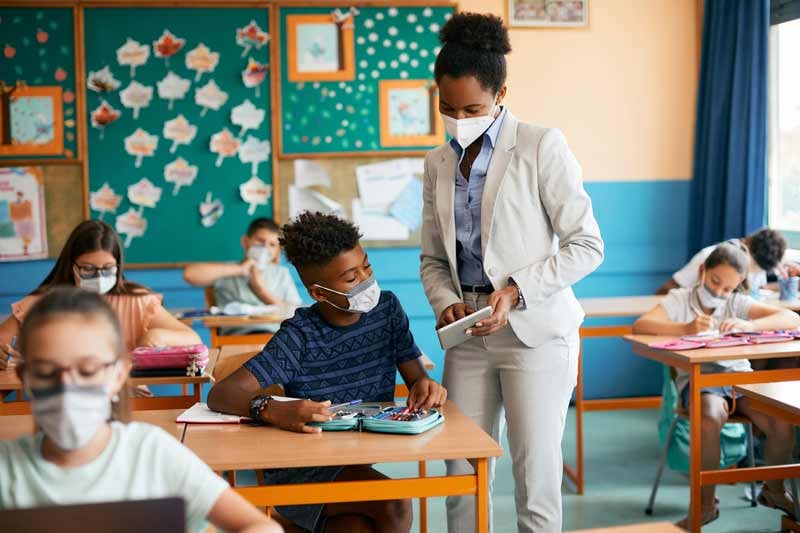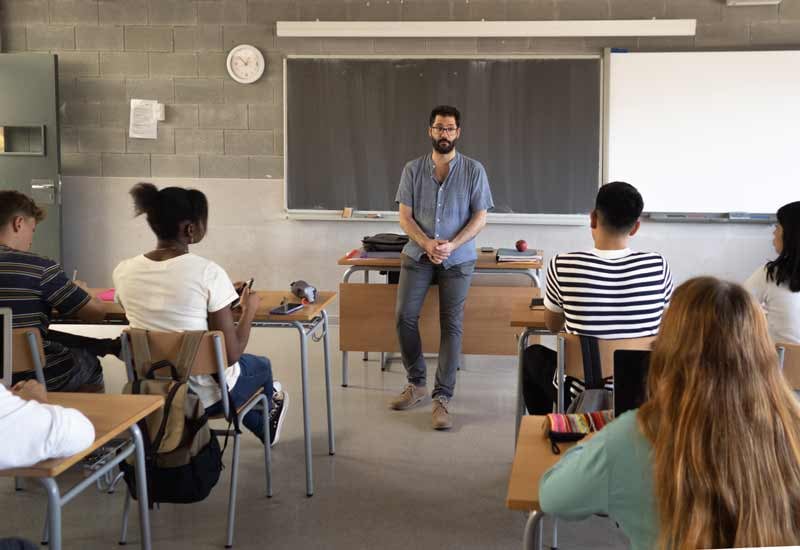
In 2021, the second round of Emergency Assistance to Non-Public Schools (EANS) was issued through the American Rescue Plan Act with a total of $2.75 billion in additional funding. Some of these funds are still available and can be used for enriching curriculum with STEM education programs like Kid Spark’s pre-K–8 STEM learning labs.
The STEM Education Gap in 2022
The last few years in the education space have been like no others before. When we started Kid Spark Education, we set out to give all students access to STEM education and disrupt the pattern of educational inequity. But the COVID-19 pandemic instigated learning gaps of its own, and students with low-income backgrounds were affected the most.
A study with the National Science Foundation found that when schools moved to remote learning in early 2020, only 57% of low-income households (below $25,000) had reliable access to a computer for education, compared to 90% in households with income above $200,000.
By Fall 2020, students in low-income households were still among those most affected by the inequities of remote education. While the majority of respondents (85%) reported that their children had regular contact with teachers at least two days of the week, 11% reported that their child had no contact with a teacher via phone, video, or in person in the past week — a percentage mostly made of those with the lowest income and education levels.
As educators strive to close the learning gap instigated by the COVID-19 pandemic, it’s essential to reinvest in educational tools and training that can help teachers close the learning gap swiftly. While the pandemic accelerated the need for STEM professionals both now and in the future, it also exacerbated the existing gap in STEM education for students from low-income households and rural communities.
Closing the STEM Education Gap with EANS
The Emergency Assistance to Non-Public Schools (EANS) program was designed to serve the low-income communities that were most affected by the pandemic. Since funds started being released by local state governors, we’ve felt the difference in the sales of our STEM lab kits and are ecstatic to see the results of these educational investments.

However, we’ve also seen a disparity between the states who have thorough and well-circulated resources for non-public schools applying to receive EANS funding, and the states who have more limited communication and resources for non-public schools to learn more.
That’s why we’ve created this guide to supply educators across all fifty states with helpful information on what EANS funding is, what is available to them, and how to receive EANS funding to invest in your students’ future STEM success.
In this guide, we’ll cover:
- What is EANS funding and what does it mean for non-public schools?
- Who qualifies for EANS funding?
- How can EANS funds be used?
- How to apply for EANS funding
- How to enrich your STEM educational programming with EANS funding
For educators, administrators, and stewards of private nonprofit schools, we hope this guide introduces you to new opportunities for your students. While many deadlines for EANS applications were closed in 2021, there is still funding available. For specific information regarding your state’s status, you can visit the website of your local State Education Agency.
Everything You Need to Know About EANS Funding
What is EANS Funding?
The First Round of EANS Funding: CRRSA EANS
The Emergency Assistance to Non-Public Schools (EANS) program was first introduced in December 2020 as part of the Coronavirus Response and Relief Supplemental Appropriations Act (CRRSA). $2.75 billion was divided between all fifty states based on each state’s percentage of low-income students enrolled in non-public schools. The funds were provided through the Governor’s Emergency Education Relief (GEER) Fund, meaning that while the funds were given by the federal government, the application and allocation process of those funds was the responsibility of each state.
These funds were specifically intended for non-public schools to pay for:
- Safety precautions of reopening schools: COVID-19 testing, ventilation systems, cleaning supplies, PPE
- Improving and adjusting curriculum: technology resources, remote and hybrid learning tools, new curriculum, remediation
- Reimbursement for costs incurred by the COVID-19 pandemic
The Second Round of EANS Funding: ARP EANS
The American Rescue Plan (ARP) Act extended the original CRRSA EANS and added an additional $2.75 billion in funding with two new and significant requirements:
First, the ARP EANS emphasized the intention of serving low-income students by requiring that a significant percentage of a non-public school’s student population (40% or the state’s approved alternate percentage) be from low-income households. This specified the intention of these funds by adding a quantified percentage for schools to qualify.

Secondly, this round of funds could only be used toward future expenses—removing the previously approved spending for reimbursing COVID-19-related costs.
While funds could still be used for new COVID-19 protocol, the lack of reimbursement for previous expenses opened more funding to be spent on curriculum enrichment and closing the learning gap imposed by the pandemic. This is the trend we saw as more administrators opened up funding for a comprehensive STEM curriculum like our lab kits at Kid Spark.
Who qualifies for the second round of EANS funding?
Any accredited non-public school that was founded prior to March 13, 2020, and was significantly impacted by COVID-19, can apply for the second round of EANS funding, if:
- They serve at least 40% (or the adjusted state poverty percentage) of low-income students
- Have not received pandemic relief funding through the Paycheck Protection Plan (PPP) loan on or after December 27, 2020.
To address students of schools that are most impacted by the COVID-19 pandemic, the federal government has instructed state education agencies to use public data to determine the most-affected schools in their state using guidelines listed in the Federal Register.
How can EANS funding be used?
In September 2021, the Office of Elementary and Secondary Education (OESE) released an update of how EANS funding could be used by non-public schools “to address educational disruptions resulting from the COVID-19 emergency.”
Health and Safety Measures
- Cleaning supplies for sanitizing and disinfecting school facilities (but not for sanitizing services)
- Personal protective equipment (PPE)
- Ventilation upgrades (ventilation systems, windows, air purification systems)
- Staff training on sanitization, PPE, and new health and safety measures
- Social distancing barriers
- CDC-recommended equipment for reopening and operating school facilities safely
- Coronavirus testing
- Leasing sites or spaces for safe social distancing
Remote or Hybrid Learning & Learning Loss
- Educational technology to assist with remote or hybrid learning (hardware, software, connectivity, assistive technology, and adaptive equipment)
- Curriculum and instruction plan development for remote or hybrid learning or to address learning loss from the COVID-19 emergency
- Transportation costs related to remote learning
- Education support services or assistance for remote or hybrid learning or to address learning loss
Using EANS Funding for Educational Programming and Enrichment
This second category of qualified EANS expenses is where Kid Spark Education has witnessed increased spending in our STEM lab kits and professional development tools for educators.

Because of the learning loss resulting from COVID-19’s education disruptions, students reentering the classroom respond quickly to the hands-on learning that our curriculum and STEM lab programs provide. Previously, the funding to implement new STEM curriculum or enrichment programs would have been a responsibility of the school or a special donation, but with the opportunities made available by the second round of EANS funding, non-public schools have way to enrich their curriculum and help close the gap in their students’ STEM learning loss.
Kid Spark STEM education programs include:
- Comprehensive STEM Program Solutions for:
- Pre-K - 1st Grade
- 2nd - 5th Grade
- 6th - 8th Grade
- Curriculum with teacher lesson plans, curriculum packets, interactive MakeCode programming tutorials, assessments, standards-alignment guides, and much more.
- Professional Learning to prepare educators for teaching STEM concepts and using program materials
- STEM Labs with the supplies needed for hands-on STEM learning
These educational STEM program materials can be used year after year to not only address the immediate learning loss from the COVID-19 emergency, but also to serve students for years to come and help close the gap in STEM education inequity.
Because Kid Spark program solutions are designed to build foundational STEM fluencies then gradually expand students’ familiarity with STEM concepts from Pre-K through 8th grade, students receive comprehensive and consistent STEM education without gaps or redundancies.
For educational institutions with more rigid curriculum schedules, we’ve seen a large adoption of our programs being purchased for educational enrichment programs with great success.
How to Apply for EANS Funding
The application process for EANS funding is managed by each state department of education. While some deadlines have closed, some designated funds for the second round of EANS might still be available, so it’s necessary to first check with your state education agency to learn the current application status. You can find your state’s department of education on this website.
Each state’s department of education will have important application dates, current enrollment status, and instructions on how your private non-profit school can apply for EANS funding.
While some states have outsourced the application process to a third-party provider, be sure that this is clearly listed on the SEA’s website before providing your organization’s information to a third-party.
Learn More About Bringing STEM Lab Kits to Your School
Whether you have EANS funding available, or any other type of funding, we’d love to talk to you about investing in your school’s STEM education. We’ve seen the results of investing in STEM education early to disrupt the pattern of educational inequity and give students of all backgrounds and abilities the foundational STEM education to nurture the next generation of successful professionals, bold thinkers, and passionate leaders.
As a result of early access and confidence in STEM concepts through our programs, students report a dramatic increase in how much they enjoy STEM learning, and educators report greater comfort in teaching STEM concepts. Kid Spark’s STEM labs are readily adopted by teachers as the most cost-effective schoolwide solution available.
If you’d like to learn more about bringing STEM labs to your school, contact us today!
.png?width=1270&height=453&name=Copy%20of%20Kid%20Spark%20Logo%20(Horizontal%20-%20Full%20Color).png)